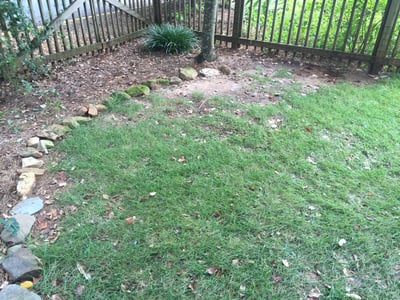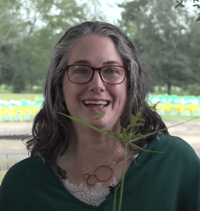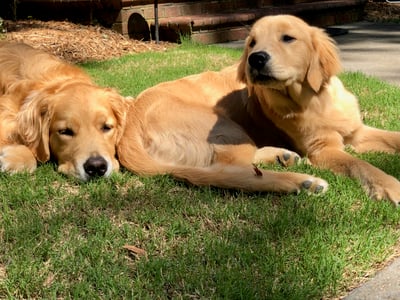

Why it's Hard to Grow Grass in Shade & Steps You Can Take


When you assess a shady area before planting turfgrass, look to see if anything is currently growing in that area. If there isn’t even a weed growing in the shade, chances are, turfgrass is not going to grow there.
One of the most common questions we get is, "I have the shady spot in my yard and my grass isn't doing very well." Well, to understand the relationship between sunlight, shade, and turf, we need to talk a little bit more in depth about what goes into this whole process, this whole complex, if you will.
Why it's Hard to Grow Grass in Shade
All plants have to have light to survive. If you remember back to your fifth grade science class, I'm sure your teacher talked to you about photosynthesis. It's the process where plants take light energy from the sun, and with the building blocks of atoms and molecules around them, turn them into sugars and carbohydrates. That energy that they create, which they convert from sunlight into sugars and carbohydrates, that's what fuels all of life.
Anytime you put any plant into the shade, you're putting it on a diet. You can put fertilizer out there in huge quantities, but if the plant's not able to get the light, then it's not able to feed. It's not able to convert that into energy via photosynthesis.
One of the things you have to realize about turfgrasses are they're from Savannah or Plains type ecosystems. We don't find turfgrass plants too much in forest type environments. They're not really from that shade ecosystem, so we need to realize that at any time if you're putting a plant into a shaded environment, you're kind of putting it into an ecosystem where it's not really comfortable at.
Two Types of Shade
- Building Shade: One would be from buildings and one would be from trees. Building shade is really interesting because it doesn't move, but it can be really solid. For instance, if you have turfgrass on the front side of a building on the north side of a building, later into the fall that could be a problem. You need to check your yard or lawn and see what kind of angles do I have? What does the sun look like when it's the highest on June 21st, and what does it look like the rest of the year? That'll give you a real good idea of how well it's going to do in a particular area if you realize that that's going to change over time.
- Tree Shade: Trees are the other big part of shade in the garden, and we need to talk about not all trees are created equal. Some trees, their shade's not too severe. For instance, pine shade. Almost all turfgrass species can do well in pine shade. But there are other trees like magnolias that have a thick really large leaf canopy that's really tough for light to get through, therefore it's really tough for turfgrass to survive there.
A Little More About Trees
There's other trees that can be problematic, as well. For instance, anything in the walnut family. These plants have developed over the years the ability to actually secrete a poison through their leaf tissue called juglone, and as it hits the ground it basically poisons all the plants underneath it somewhat. Some plants are more susceptible than others. But if you're in that walnut family, which are pecans, walnuts, and hickories especially, it can be really tough to grow turfgrass under those trees.
If you have problems ID'ing your trees, talk to your local extension agent. He can help you out with that. But many times, it's more about the type of tree and the light that's getting through it than just the tree alone.
How to Tell How Much Shade You Have
We need you to talk a little bit about how to assess your site to see if turfgrass is going to do well there or not. One thing that we need to realize and when we talk about this is the human eye is really poor at seeing degrees of shade. We can tell if there's shade there are not, but the amount of shade there or how heavy that shade is, the human eye is really poor at.
Look at this diagram, letter A and letter B (in the video). Now, you're not going to believe this and some of our folks still don't believe it until they cut it out and lay them side by side, but A and B are the exact same shade. It doesn't look like it from the diagram, and that's the optical illusion. That shows you, it illustrates why the human eye is so poor at seeing degrees of shade. A and B are the exact same color.
When you go out on your site, since you know that the human eye is not that great at seeing at how heavy the shade is, is to look at the area. Is there anything growing there now? If you go to an area and there's not even a weed growing underneath the tree, chances are turfgrass isn't going to grow there as well.
Tricks to Grow a Lawn in the Shade
- There're several things we can do to the trees that'll help the turfgrass grow. Simply limbing up the trees, to take those lower limbs off, to prune them back, just reducing those lower limbs so more sunlight can get through that canopy can make a huge difference in the quality and the ability of your turf to withstand shade.
- One easy we can do is just remove the number of trees in an area. Say you have a thick area of eight or nine pine trees. You take out three or four of those, it can make a huge difference of the amount of light that reaches your turfgrass and still provide that nice cooling shade that we all like.
- The last step in the process is picking the right turfgrass. Now, many times folks jump right to this last step and hope that if they pick the right turfgrass that'll work and fix their shade problem. Well, there's no silver bullets in the turfgrass. As you've seen from this whole segment, shade is a pretty complex issue, so if we just try to fix it with just the genetics, just the type of turfgrass, we're probably going to fail. You still need to work through all these steps to make sure that turfgrass will do.
More on Picking the Right Turfgrass
There is big differences in the different turfgrasses ability to withstand shade. For instance, Bermuda grasses. That's still the predominant long grass in the southeast. However, Bermudas, as a general rule, are really poor in the shade. They require full sunlight. Until the release of TifGrand and TifTuf Bermuda, which can tolerate a moderate amount of shade. They changed the equation a little bit, so we can look at Bermuda's as well. But your regular Tifway 419 Bermuda is really poor in the shade and it's the most popular long grass in the south, so that's probably why we're talking about this in the first place.
There's other grasses we can talk about, as well. For instance, in the upper south where the temperatures are cooler, Charlotte, upper suburbs of Atlanta, for instance, fescue is really hard to beat in the shade. It does well there. In the lower south, Mercedes St. Augustine does really, really well in the shade. St. Augustine's generally do really well in the shade, but not all St. Augustine's are shade tolerant. For instance, there's Floratam that has no shade tolerance whatsoever, so you also need to not only look at the specie of turfgrass, but also the variety.
Centipedes do really well in acid shade situations, like pine shade. Not super heavy oak type shade, but pine shade where you have acidic soils, centipedes do really well there.
Fine textured Zoysias do great in the shade in a really broad area. They need some sunlight, and preferably some direct sunlight. Not all day, maybe two or three hours, but they do really well in shady conditions, as well. Of course, thicker textured Zoysias can do well in shade if we mitigate some of these factors, as well.
There's a lot of people out there that'll tell you, "I've got a grass that does great in the shade in all locations." Well, I don't really think that's the way of it. If you look at this whole complex issue of shade we've been talking about, it's complex. And to say, "Oh, I have a grass that'll fix all the problems," well, that's not really the case. We need to look at all these issues to make sure that in your lawn, your turf is going to do the best it can do, and really where you'll have that nice lush lawn that you're looking for.
Today, I'd like to talk to you about some of the problems that grass can have growing underneath the tree. The shade. The shade can reduce photosynthesis, which weakens the plant, weakens the root growth. You'll also have to understand that underneath the tree, there are roots on the tree, also, and the tree and the grass roots are competing. They're competing for water and nutrients, and that weakens the tree as well as the grass, so it is a problem.
Some people don't think about the increase in disease problems with the trees. So increasing shade, the plants don't dry out as quickly, and that leads to more disease. So that can be the problem, the shade, the reduction in photosynthesis, the competition for water and nutrients, and the increase in disease. It all makes for a weak turf underneath the tree.
So what can you do? You can increase the amount of light underneath the tree. You can raise the crown of the tree. You would like to see the crown of the tree, that's the lowest branch of the tree, to be about eight feet above the ground, or even higher if possible. You get more light. You can go through and thin the tree a little bit. Some branches try to open up the light.
Of course, there are some trees growing grass underneath the tree is much more problematic than others. Things like magnolias, willows, water oaks, willow oaks, oaks in general, can be very difficult to grow grass underneath those trees with their dense shade. High branch trees, particularly like pine, you can grow grass closer to the tree.
So, those are the things you can do to the tree to increase the growth of grass underneath the tree. You can select different cultivars or different species of grass that do better in shade. Things like fine fescue, tall fescue, do well underneath the tree. Some of the warm season grasses like Zoysia in particular, cultivars of Zoysia, and then also St. Augustine do well. Bermuda, it is more problematic. There are certain cultivars, TifGrand is one cultivar that will grow better underneath the tree.
So what if your grass is really struggling and you've given up on the grass? What can you do? One very important thing you can do is mulch the tree. The tree loves mulch. You think in the woodland situation, it's covered with organic matter from its own leaves and other plants, and so you bring it in a pine bark or a pine straw and mulch underneath the tree. That will cover those surface roots that you have with some of your water oaks and your maples. Those roots that grow along the surface, it's not good to nick those as you're mowing, so you can cover those with mulch. You could plant a ground cover underneath the tree. Something that grows better in the shade.
Maintenance-wise, taking care of your grass, what can you do to increase growth near a tree? Several things you can do. Of course, you've got this incredible competition between the roots of the grass and the roots of the tree, and you need to add more or provide more water for the grass. Typically, you would like to double the amount of water near the tree so that grass can compete.
You also want to raise the level of mowing. If you mowed it one inch, your grass, you might want to raise it to two. If you mowed it two, you might raise it to three. This increases root growth, because you get more carbohydrates when you have more foliage on the plant. That gets more root growth, deeper root growth, and you get more water.
You also want to restrict the competition in that area. The grass is growing weakly, and if you walk on it, it makes it even weaker, so you want to restrict any kind of walking around that area. Keep the leaves as they fall off the grass, anything that would intercept the light, try to reduce that.
We've always said a good baseline measurement for the amount of sun you need in a lawn is four to six hours of direct sunlight. Well, we'd really like for you to get out there and look at your lawn area over the entire day, because the sun tracks from east to west and is it moves, the shadows and the shading is going to change over the entire day.
If, for instance, you have sunlight during the middle part of the day when the sun is at its greatest intensity, maybe you can get away with less than that. But if it's early morning or late afternoon when the sun is not so intense, maybe you need a few more hours than that.
So it's really important to look at each site in particular. Like we said, that's just a good general idea, but each site's different so you really need to assess it. We're more than willing to have our folks come out and help you assess your site. We have light meters. We can actually measure and tell you whether or not we think turf is going to do well, or the turf of your choice is going to do well on a particular site. So, we're always willing to help you do that.
What can you do?
- Assess the amount of sunlight on your site over the entire course of the day.
- Remove lower limbs of trees to increase the amount of light.
- Reduce the number of trees in an area.
- Use mulch directly under trees instead of turf.
- Mow lawns in the shade at a higher setting.
- Keep leaves off the lawn.
- Restrict walking on a lawn that's too shaded.
- Choose the right turfgrass for your shade conditions and location.
- Read our article on how to lay sod around trees.
- Read our article on how to grow grass in the shade if you have dogs.




